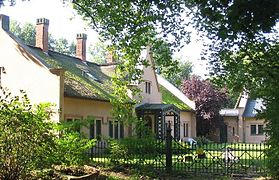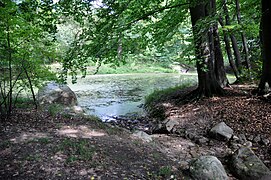The black abbot
| Movie | |
|---|---|
| German title | The black abbot |
| Original title | The black abbot / Le Crapaud masqué |
| Country of production | Federal Republic of Germany , France |
| original language | German |
| Publishing year | 1963 |
| length | 89 minutes |
| Age rating | FSK 12 |
| Rod | |
| Director | Franz Josef Gottlieb |
| script |
Johannes Kai , Franz Josef Gottlieb |
| production |
Rialto Film ( Horst Wendlandt , Preben Philipsen ), Les Films Jacques Leitienne |
| music | Martin Böttcher |
| camera | Richard fear |
| cut | Hermann Haller |
| occupation | |
| |
The Black Abbot (French title: Le Crapaud masqué ) is a German-French co-produced crime film that was shot in 1963 under the direction of Franz Josef Gottlieb . The film adaptation of the novel of the same name (original title: The Black Abbot ) by Edgar Wallace is the 15th German-language Edgar Wallace film of the post-war period . The black and white film premiered in Ultrascope on July 5, 1963 in the Universum in Munich .
action

In the ruins of Fossaway Abbey, England , a certain Mr. Smooth, the owner of a nearby hunting lodge, is stabbed to death. Dick Alford, manager of nearby Chelford Manor, discovers the body. Before he calls the police, he asks his cousin, the opaque lord of the castle, Lord Harry Chelford, to indicate that he has not left his room that evening if he has any unpleasant questions. The well-informed butler Thomas Fortuna has long known about the dead man. He watched the excited lord come into the castle after the murder, and shortly thereafter Dick Alford. The next day, Scotland Yard's Inspector Puddler and his assistant Horatio W. Smith move into Chelford Manor. The officials think little of the rumors that the murderer is an old ghost, the so-called "Black Abbot". The emergence of questionable people and mysterious events seem to have no end. Thomas Fortuna turns out to be a former convict. Mary Wenner, Lord Harry's former secretary, was banned from the castle by the castle steward after she became too interested in her boss and a fabled pot of gold . Instead, the young and attractive Leslie Gine want with Lord Harry engaged . However, Leslie feels more drawn to Dick Alford and makes no secret of the fact that the planned marriage to the lord of the castle is an idea of her brother Arthur Gine.
He is the lawyer and syndic of Lord Harry. He's had money troubles since losing significant sums of money in horse betting . He didn't count on the cunning of his office manager Fabian Gilder, who is also after Leslie. Gilder has some fake bills of exchange that he uses to extort gine. As a bookmaker under a false name , he also relieved his boss by exactly £ 160,000 . Mary Wenner shows up at the office. Since she desperately wants to adorn herself with the title Lady , she demands that Gine prevent his sister's marriage to Lord Harry. She offers the attorney a million pounds for it and claims to know where the gold is. Inspector Puddler and Detective Assistant Smith visit Fabian Gilder in the cabin on the same day. As the investigators already know, the murdered Mr. Smooth bought the building as a front man for Gilder. Arthur Gine asks Dick Alford to acknowledge the fake bills of exchange to thwart Gilder's dirty plans. In the cabin, Alford can just prevent the pushy Gilder from attacking Leslie.
While Lord Harry Chelford is looking intently for clues about the gold treasure, Fabian Gilder has allied himself with Mary Wenner. Under cover of darkness, the two actually discover a secret passage under the abbey. However, they only contain one of the containers hidden there. They flee when Mrs. Wenner claims to have seen the "Black Abbot". Detective Assistant Smith is unceremoniously put down by the supposed ghost, under whose robe Dick Alford is observing what is going on at the ruin. A little later Gilder returns to the abbey. He must find that the remaining containers have disappeared in the meantime. Mary Wenner, who followed him, is shot dead by an unknown hand in front of him. The next morning, Lord Chelford receives a letter in which Leslie Gine terminates the engagement. The man, increasingly suffering from an inherited nervous disease, blames his cousin Dick for it. The following night the lord also goes to the ruins of the abbey. There he meets his mother, who is believed to be dead, Lady Joan Chelford and the "Black Abbot". Both are shot by the confused lord. As it turns out, this time the butler Thomas was under the robe on behalf of Gilders - as he had when he stabbed Mr. Smooth. Inspector Puddler also learns that Dick Alford and family doctor Dr. Loxon had kept the nervous mother away from her son on the pretext that she had died years ago. The Scotland Yard official now suspects the unscrupulous machinations of Mr. Gilder. He finally shoots his rival Arthur Gine.
Dick Alford, Inspector Puddler and Detective Assistant Smith learn that Lord Harry, in his madness, has dragged the helpless Leslie Gine into the dark vaults below the abbey. Using the plan from the mysterious containers that Dr. Loxon once saved from access by Fabian Gilder, Alford and the investigators gain access to the catacombs. After discovering the body of the slain Mr. Gilder in a space in between, they can advance to the mentally deranged Lord Chelford. Dick Alford is able to free Leslie Gine at the risk of his life. Due to an exchange of fire, part of the old vault collapses. As a result, the Lord is buried under the rubble and the actual gold treasure is exposed.
History of origin
Background and script
The enormous success of the Edgar Wallace film series marketed by Constantin Filmverleih continued unabated at the end of 1962 / beginning of 1963. After the Rialto film production Das Gasthaus an der Thames , which premiered in autumn 1962, the film The Curse of the Yellow Snake, produced by Rialto competitor CCC-Film , started in cinemas in February 1963 . For Horst Wendlandt's Rialto Film, the following Wallace films were initially planned in 1963:
- The zinc man
- The Traitor's Gate , realized at the end of 1964
- The derby winner , not realized
- Der Unheimliche , realized in 1963 under the title The Indian Cloth
The Zinker could be filmed on schedule from the end of January to the end of February 1963 under the direction of Alfred Vohrer . The film project The Traitor's Gate , which has been postponed again and again since 1962 , could still not be realized. The adaptation of the novel Der Derby Winner , also planned for 1963 , was even rejected entirely. Instead, Gerhard F. Hummel , the lead program advisor at Constantin Filmverleih, resorted to the film adaptation of The Black Abbot . The corresponding script was written by the commissioned author Johannes Kai alias Hanns Wiedmann in the summer of 1962. The novel The Black Abbot was first published in 1926 under the original title The Black Abbot . The German first edition was published by Wilhelm Goldmann Verlag in 1930, and since 1955 the work has been available as Goldmanns Taschen-Krimi Volume 69 .
The British Terence Fisher was initially considered as a director . The choice fell on the Austrian Franz Josef Gottlieb , who had already successfully staged The Curse of the Yellow Snake . The director made a few changes to the script, which remained comparatively close to the novel.
occupation
Originally, the main actors Heinz Drache and Richard Münch were announced for The Black Abbot . Even with the cast that was ultimately engaged, they largely relied on actors who were already established in the film series, including Joachim Fuchsberger , Dieter Borsche , Charles Regnier , Werner Peters , Harry Wüstenhagen , Eddi Arent and Klaus Kinski . Eva-Ingeborg Scholz and Alice Treff had one - off guest appearances within the film series . The female lead actress Grit Boettcher was to take on another role in a Wallace film in 1967 in The Monk with the Whip .
production
The shooting for the black and white film with a colored title sequence produced in Ultrascope took place from April 17 to May 28, 1963. Some of the exterior shots were taken at Herdringen Castle , which served as the backdrop for Chelford Manor and was already seen as Longford Manor in the film The Forger of London . Most of the filming locations were, however, in the Klein-Glienicke Park in Berlin-Wannsee . This time it was possible to dispense with London recordings entirely. The CCC-Film studios in Berlin-Haselhorst served as the film studio . The film structures , including the ruins of the abbey, came from Wilhelm Vorwerg and Walter Kutz . Irms Pauli was responsible for the costume advice . Manager was Wolfgang Kühnlenz . Erwin Gitt acted as production manager . With Les Films Jacques Leitienne , a French co-production partner contributed to the production costs of an Edgar Wallace film for the third time .
- Filming locations in the Klein-Glienicke Park
Film music
The soundtrack was penned by Martin Böttcher , who composed his third soundtrack for an Edgar Wallace film for The Black Abbot . Three tracks from it are included on the CD Kriminalfilmmusik by Martin Böttcher from 1996:
- Theme music 2:29
- In the crypt 3:44
- A Colorful Dream 2:37
The theme music is also included on the 2002 CD The Best of Edgar Wallace .
reception
publication
After the first examination on July 3, 1963, the FSK approved the film from the age of 16. Since the film was released in cinemas during the summer holidays and was supposed to be approved for ages 12 and over with consideration for a young audience, the film had to be shortened by three scenes:
- The murdered lawyer Gine twisted his face in agony
- Lord Chelford drags Leslie Gine in the underground vaults from left to right and suddenly throws her body down
- Lord Chelford turns around under the falling stone in the catacombs
After another sighting, on July 12, 1963, they were approved for children aged 12 and over. In the meantime, the film premiered on July 5, 1963 in the Universum in Munich. During its premiere, the film had around 2.7 million viewers in Germany. In the polls carried out by the trade journal Filmecho / Filmwoche at the time , in which the cinema visitors rated current films on a scale from 1 (excellent) to 7 (very bad), The Black Abbot received a grade of 2.9. For comparison: The crime films Der Zinker (2.4), Der Würger von Schloß Blackmoor (3.1) and The Black Cobra (3.2), also published in 1963 . The black abbot started in French cinemas on July 8, 1964 under the title Le Crapaud masqué .
The film could be marketed in other countries and ran there under the following titles:
- Denmark : Murder på stribe
- Finland , Finnish title: Salapoliisin johtolanka
- Greece : I Scotland Yard sta apokryfa tou Soho
- Italy : Edgar Wallace e l'abate nero
- United States : The Black Abbot
In the GDR , the film was shown in cinemas from September 4, 1970. The first broadcast on German television took place on February 12, 1974 on ZDF . In 1991 it was published as a purchase video. The video and, for many years, the television versions were shortened beyond the FSK requirements and were shown in the wrong film format and sometimes even mirrored. In addition, the original colored opening credits had been replaced by a black and white opening credits. In the meantime, the film has been released on DVD in the uncut original version, which also contains the takes that were once censored by the FSK . This version was also released from the age of 12.
Reviews
“A certain Mr. Gottlieb directed the film; the gags and tricks come from the panopticon of an Anglo-Saxon crime museum. "
“This 13th Edgar Wallace film [the Rialto Film] continues the tradition of its predecessors. Director F. J. Gottlieb made the 'black abbot' quite exciting and the actors helped him to the best of their ability. "
“In this Wallace flick, too, the plot is multilevel and confusing in favor of all possible tension effects. Dieter Borsche resides in a haunted castle, close to madness, surrounded by dark figures who sneak through the park at night in search of a fabulous treasure. Joachim Fuchsberger and Scotland Yard casually and carelessly clarify the case in which the distinctive Eva-Ingeborg Scholz is also involved. Well-photographed crime thriller, probably meant as morality. "
"A story that is opaque even to the police, but which [...] offers enough action, horror and macabre jokes with dynamic background music."
"Bizarre ghost thriller."
“'The Black Abbot' was the 13th Wallace film adaptation [the Rialto movie]. Bad omen? No sir! She became one of the most faithful to the work. Charles Regnier's gentleman-like style is particularly amusing. "
"Grave horror for Wallace fans."
"Series product that disappoints even outspoken genre fans."
"'The Black Abbot' is one of the most famous and scariest Edgar Wallace films, which comes up with beautiful, fog-shrouded images and creates a cozy, creepy atmosphere."
literature
- Edgar Wallace: The Black Abbot / The Strange Countess / The Dead Eyes of London . Three novels in one volume. German translation. Goldmann Verlag, Munich 2007, ISBN 978-3-442-55504-8 .
- Joachim Kramp , Jürgen Wehnert: The Edgar Wallace Lexicon. Life, work, films. It is impossible not to be captivated by Edgar Wallace! Verlag Schwarzkopf & Schwarzkopf, Berlin 2004, ISBN 3-89602-508-2 .
- Joachim Kramp : Hello! This is Edgar Wallace speaking. The story of the legendary German crime film series from 1959–1972 . 3. Edition. Schwarzkopf and Schwarzkopf, Berlin 2005, ISBN 3-89602-645-3 .
- Florian Pauer: The Edgar Wallace Films . Goldmann, Munich 1982, ISBN 3-442-10216-2 (Goldmann 10216, Goldmann Magnum , Citadel-Filmbücher) .
Web links
- The Black Abbot in the Internet Movie Database (English)
- The black abbot at filmportal.de
- The black abbot ( memento from December 26, 2007 in the Internet Archive ) at deutscher-tonfilm.de
- Sound carrier with the film music
Individual evidence
-
↑ Original version: 88 minutes for cinema projection (24 images / second), 85 minutes for television reproduction (25 images / second), film length: 2426 meters;
FSK version 1963: 89 minutes for cinema projection (24 images / second), 85 minutes for television playback (25 images / second), film length: 2420 meters - ↑ Joachim Kramp: Hello! This is Edgar Wallace speaking. The history of the crime film series from 1959 to 1972. Third, revised and expanded edition . Schwarzkopf & Schwarzkopf, Berlin 2005, ISBN 3-89602-645-3 , p. 188 .
- ^ Joachim Kramp and Jürgen Wehnert: The Edgar Wallace Lexicon. Life - work - films . Schwarzkopf & Schwarzkopf, Berlin 2004, ISBN 3-89602-508-2 , p. 47-78 .
- ↑ Booklet of the CD Kriminalfilmmusik by Martin Böttcher . BSC Music. 1996. Order no. 307.6518.2
- ^ CD The Best of Edgar Wallace . All Score Media. 2002. Order no. ASM 005
- ↑ Joachim Kramp: Hello! This is Edgar Wallace speaking. The history of the crime film series from 1959 to 1972 . 3rd, revised and expanded edition. Schwarzkopf & Schwarzkopf, Berlin 2005, ISBN 3-89602-645-3 , p. 192-203 .
- ^ Joachim Kramp and Jürgen Wehnert: The Edgar Wallace Lexicon. Life - work - films . Schwarzkopf & Schwarzkopf, Berlin 2004, ISBN 3-89602-508-2 , p. 97 .
- ↑ Release Certificate for The Black Abbot . Voluntary self-regulation of the film industry , October 2004 (PDF; test number: 99 805 DVD).
- ↑ The black abbot . In: Hamburger Abendblatt . September 4, 1963, p. 5 .
- ^ The black abbot. In: Paimann's film lists . No. 2809 of September 18, 1963 (PDF) ( Memento of August 18, 2017 in the Internet Archive ).
- ↑ Television Tuesday, February 4, In: Der Spiegel . No. 6 , 1986 ( online ).
- ^ The black abbot. In: Lexicon of international film . Film service , accessed June 25, 2017 .
- ↑ Stefanie Rufle: film review at moviesection.de






